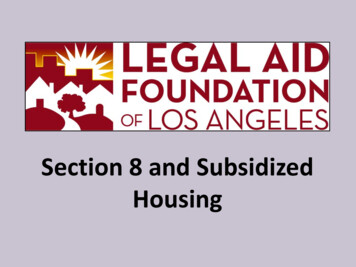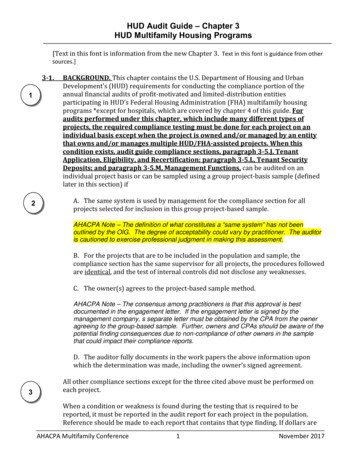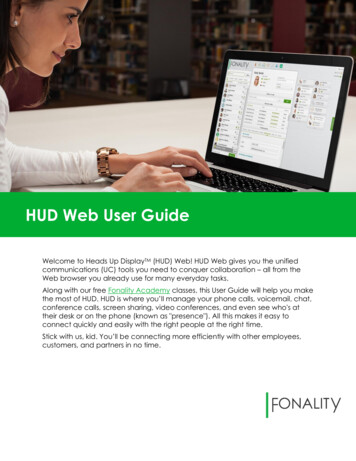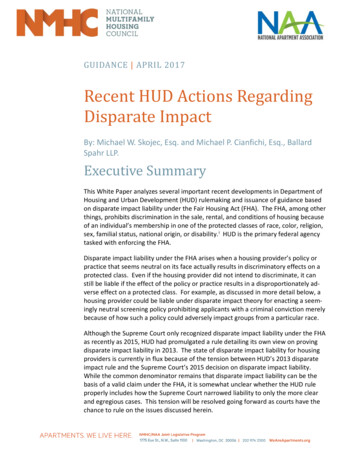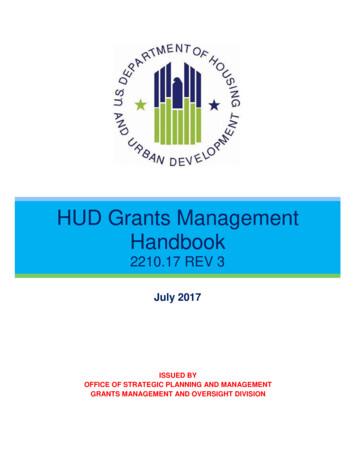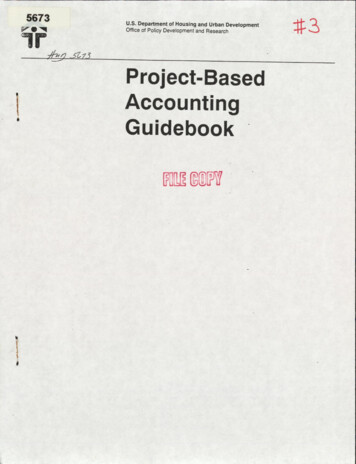
Transcription
J',t;r":" 'l :;"lj'iW "'---"'.J t. J ,This report was produced by OKM Associates, Inc. forthe United States Department of Housingand Urban Development. The views and conclusions contained herem are those of the authorsand should not be interpreted as necessarily representing the official views or poliCies of theUmted States Government.
. Project-Based AccountingGuidebookPrepared for:u.s. Department of Housing and Urban DevelopmentOffice of Policy Development and ResearchPrepared by:OKM Associates, Inc.Boston, MassachusettsContract HC-5834 1October 1990
- - - - - ---------,PREFACEThis ProJect-Based Accounting GUidebook is the final product of a researcheffort to develop a standard project-based accounting system for pUblic housingagencies (PHAs). The Guidebook IS a document for PHAs to use in converting from aconsolidated to a project-based accounting system. The following is a list of the GUidebook chapters. Each chapter buiids onthe information provided in the prevIous chapters, leading PHA staff through aprocess for designing, selecting and Implementing a P-BA system which meets theparticular management needs of a PHA.Chapter One - Introduction to Project-Based AccountingChapter Two - Mimmum ReqUirements for a Standard ProJect-BasedAccounting SystemChapter Three - Enhancements to the P-BA System Which Supports InternalManagement NeedsChapter Four - The Process for Deslgmng, Implementing and Maintaining aProject-Based Accounting SystemChapter Five - Determining the Cost to Convert to a P-BA SystemSupplementing the Information contained In the five chapters are fourappendices. Appendix I provides Sample P-BA Report Formats. Appendix II offers amodel Project-Based Solicitation Package for a PHA that wishes to obtain technicalassistance in the development, installation, and maintenance of a P-BA system; andan RFP for procuring an automated P-BA system. Appendix III includes a SampleChecklist for Steps to Follow In Evaluating P-BA Systems, and Appendix IV provides"four PHA Case Studies examining the process the PHA underwent to install P-BA.
TABLE OF CONTENTSCHAPTER ONE: INTRODUCTION TO PROJECT-BASED ACCOUNTINGINTRODUCTIONWHAT IS PROJECT-BASED ACCOUNTING?MANAGEMENT USES OF PROJECT-BASED ACCOUNTINGWHAT TYPES OF PHAs WILL BENEFIT MOST FROM P·BA?CONTENTS OF THIS GUIDEBOOKSUMMARyCHAPTER TWO: MINIMUM REQUIREMENTS FOR A STANDARDP-BA SySTEMINTRODUCTIONMINIMUM REPORTING REQUiREMENTSMINIMUM REQUIREMENTS FOR ACCOUNTS TO BEINCLUDED IN A P-BA SySTEMCOST ALLOCATION AND DISTRIBUTION OF INCOMEAND EXPENSESSUMMARyCHAPTER THREE: ENHANCEMENTS TO A P-BA"SYSTEM WHICHSUPPPORTS INTERNAL MANAGEMENT NEEDSINTRODUCTIONDESIGN AND DEVELOPMENT OF COST CENTERSENHANCEMENTS TO ACCOUNTS WHICH CAN BECONTROLLED AT THE PROJECT-LEVEL.COST ALLOCATION DECISIONS UNDER PROJECT-BASEDACCOUNTINGENHANCED REPORTING CAPABILITIES OF A P-BA SYSTEMPROJECT-BASED BUDGETINGSUMMARy CHAPTER FOUR: THE PROCESS FOR DESIGNING, IMPLEMENTING ANDMAINTAINING A PROJECT-BASED ACCOUNTING SYSTEMINTRODUCTIONSETTING GOALS1123811121515161827293131323645526062656566
Step 1: Define the Process and Goals69Step 2: Define the Roles of Key Parties in the Process71Step 3: Examine the Current System and eeds forManagementChanges75Step 4. Develop System Specifications77Step 5: Develop a Request for Proposals81Step 6: Select the System83Step 7. Install the System85OPERATION OF A PROJECT-BASED ACCOUNTING SySTEM93SYSTEM EVALUATION AND MAINTENANCE.94,. THE ONGOING ROLE OF USER GROUPS. .95ONGOING TRAINING96SUMMARy97CHAPTER FIVE: DETERMINING THE COST OF CONVERTINGTO A P-BA SySTEM99INTRODUCTION99THE COMPONENTS OF COST100DESIGN AND PROCUREMENT COSTS102DATA CONVERSION COSTS103OPERATIONAL AND STAFFING CHANGES104TRAINING104OPERATING COSTS104SOURCES OF FINANCiNGSUMMARy 105106
EXHIBITS1-1PROJECT BASED ACCOUNTING SYSTEM2-1MODIFIED HUD FORM 52599 - MINIMUM ACCOUNTS FORA P-8A SySTEM193-1HIERARCHAL COST CENTER STRUCTURE.353-2ANYTOWN PHA PROJECT-BASED ACCOUNTING SYSTEM:.MONTHLY REPORT ON PROJECT EXPENSES393-3FLOW CHART OF TYPICAL ALLOCATION PROCESS513-4ANYTOWN PHA PROJECT-BASED ACCOUNTING SYSTEM:MONTHLY REPORT ON PROJECT EXPENSES - ELDERLY55ANYTOWN PHA PROJECT-BASED ACCOUNTING SYSTEM:MONTHLY REPORT ON PROJECT EXPENSES - FAMILY563-53-6 5ANYTOWN PHA PROJECT-BASED ACCOUNTING SYSTEM:MONTHLY REPORT ON MAINTENANCE LABOR COSTS574-1DESIGNING AND IMPLEMENTING A P-BA SYSTEM684-2P-BA IMPLEMENTATION FLOW CHART874-3P-BA IMPLEMENTATION CHECKLIST915-1COST ESTIMATES FOR A PROJECT-BASEDACCOUNTING SYSTEM100
APPENDICESAPPENDIX I:SAMPLE P-BA REPORT FORMATSAPPENDiX II:P-BA SOLICITATION PACKAGEAPPENDIX IIA:REQUESTS FOR PROPOSALS TO PROVIDE AUTOMATION SERVICESAPPENDIX liB:REQUESTS FOR PROPOSALS TOPROVIDE TECHNICAL ASSISTANCE INDEVELOPING A P-BA SYSTEMAPPENDIX III:SAMPLE CHECKLIST FOR PHAS TO FOLLOWIN EVALUATING P-BA SYSTEMSAPPENDIX IV:PHA CASE STUDIES
CHAPTER ONEINTRODUCTION TOPROJECT-BASED ACCOUNTING INTRODUCTIONPublic Housing Agencies (PHAs) have evolved as some of the most complex real estate operations in the country. PHAs operate housing In a-highly regulatedenvironment which IS constantly changing. Funding programs have become morenumerous and complex. Over the past several decades, the housing stock has aged,and houses a more diverse and lower income population than in the past. PHAs areexpected to provide both housing and social services to their reSidents, but limitedpublic funding and high public expectations make it increasingly difficult to allocatelimited resources to meet all needs of low-income reSidents and sustain the operationsof PHAs.In this context, strong and competent management is even more essential thanin most private real estate operations. Cost-effective management reqUires managersto have sufficient I formation so that appropriate deciSions can be made concerningallocation of limited resources. This dictates that effiCient financial and managementsystems be implemented to support the difficult deciSions regarding allocation ofresources among a PHA's housing developmentsMost PHAs maintain a consolidated budgeting and accounting system. Theconsolidated system, which combines the operating revenues and expenses of theentire public housing portfolio of a PHA, is the budgeting and reporting method whichhas been required by the U.S. Department of HOUSing and Urban Development (HUD)for Low Rent Public HOUSing since the 1950s. From the HUD perspective ofmanaging the program, the consolidated ACC budgeting and reporting system hasworked well and has Simplified monltonng and reporting requirements. However, from a property management perspective, a consolidated system may not provide all theaccounting and budgetary Information that is needed for deCision-making andaccountability for proJect-level operations. HUD recognizes that the managementinformation needs of PHAs extend beyond the baSIC reporting requirements, and thatSignificant technological advances in computer technology make It both possible andPage 1
cost effective to collect project-level information in support of management.Collecting umform data at the project level will serve to expand analysis of publichousing Issues. Information on uniform project level financial data is useful to HUD inits efforts to stUdy and analyze public housing. Accordingly, HUD supportsimprovements to public housing management through implementation and use ofProject-Based Accounting (P-BA) systems. This gUidebook is for PHAs that want to convert from a consolidated to a P-BAsystem. It addresses the minimum reqUirements for operating a project-basedaccounting system, enhancements and modifications which support management at the project level, and mechanisms needed to implement and operate a project-basedsystem. It is not intended to replace or interpret any HUD regulations, handbooks,recordkeeplng standards, or reporting requirements. This guidebook has benefitedfrom the expenences of 15 PHAs ",:,ho partiCipated in the study of P-BA in the winter of1989-90. It reflects a broad set of P-BA expenences and applications, includingseveral PHAs which have not implemented P-BA.lWHAT IS PROJECT-BASED ACCOUNTING?Project-based accounting s the term used to describe accounting systemswhich track income and expenses at the project level. A P-BA system permits a PHA todirect-eharge items to a project, or to allocate items among projects when dlrect charging is not pOSSible or cost effective. By direct-charging and allocating expensesto projects, a PHA can track and report on operations at the project level, and use thatinformation to make managerial deCisions. As such, P-BA is more than just a system ofaccounting, It is also a management system that provides information on the operationofpublic housing at the project level.To be considered a functional P-BA system, the system must incorporate atleast the following components:" 1The 15 PHAs represented both medium size (500 - 1,250 conventional public housing units) andlarge size (over 1,250 units). Of the 15 PHAs selected for the study, 9 were P-BA sites Of the SIXPHAs categonzed as non-P-BA sites, four had the informational systems capacity to implementproject-based accountingPage 2
It must be capable of tracking fInancial and operational information byprOject number' it must have the capacity to track all relevant Income and expenseaccount categones which can be controlled at the project level; it must incorporate an acceptable methodology for allocating incomeand expenses which cannot be direct-charged to the project level,namely those items that are non-project-specific or are related to central office operations; and it must report timely, accurate, and useful financial and operationalinformation to management staff to enable them to make deciSions aboutoperations at the project leve\.2Although the minimum requirements of a P-BA system are definedInChapterTwo, P-BA may take different forms depending on the charactenstics and needs ofindividual PHAs. Factors such as organizational structure, Size, hOUSIng stock,reSident population, management and maintenance delivery systems, and financialcondition influence the deSign of the P-BA system and the information it reports toPHA managem nt. Further, it is possible for the PHA to decide to partially adopt aP-BA system, or to implement components that are useful to the organization and ItSoperations. Such deCisions, Including the definition of P-BA as it applies to thespeCifiC agency, must be made by PHA management.MANAGEMENT USES, OF PROJECT-BASED ACCOUNTINGProJect-Based Accounting systems are management systems as well as systemsof accounting. The P-BA system functions in conjunction with PHA operations, andmust support management deCision-makIng. The eXistence of project levelaccounting aloneISinsuffiCient to justify P-BA. The P-BA system will fall, or at least 2 To minimize confusion and be consistent With HUD terminology the term "development" will be usedin this gUidebook instead of proJect, atthough denvatlons such as "Project Manager" continue incommon usage Also HUD refers to occupants of public hCusmg as reSidents rather than tenants,however, the term "tenant" has generally accepted uses In the accountmg area, such as TenantAccounts Receivable.Page 3
will be of marginal use, if it is viewed as a static, stand-alone system. The informationmust also be recognized and used in internal management decisIon-making.Following is a depIction of the dynamic elements of a P-BA system: its Inputs,outputs and management uses. The management uses are the feedback loop, thedynamic elements of the system whereby P-BA mformation IS used to influence avariety of management systems. (See Exhibit 1-1)If used to ItS full capability, P-BA can provide important managementinformatIon on a vanety of topics. These Include: financial planning, budgeting, .intemal audit and control, project-level management decision-making, andperformance monitoring.Financial PlanningP-BA Information can support financIal plannmg activities with respect to cashmanagement, funding requirements at the proj ct level, matenals requirements, andthe investment program. It can also link operating statistics of public housingdevelopments with financial data, whIch supports the management of theComprehensive Occupancy Plan, Tenant Accounts Receivable, and work orders.P-BA operating charactenstlcs can provIde useful informatIon on themanagement and mamtenance needs of a particular project. P-BA information can beused to assess the financial Impacts of operatIonal and capital needs andimprovements, whIch then can be reflected in a PHA's Comprehensive Plan forModernization (CPM), Comprehensive Occupancy Plan (COP), and other planswhich are designed to link capital and operating activities. P-BA systems can provideinformation needed to monitor the effectiveness of prOJect-based management andcapital Improvements Page 4
EXHIBIT 1-1PROJECT-BASED ACCOUNTING SYSTEM INPUTSACCOUTING SYSTEMOUTPUTSPrOject level:mQtlmamtenance actIvitiesAccountstSubaccountsHUD RepOrtsI-- . Cost CentersIncome/ExpensesCost AllocatIoninventory. purchase orders andcontractstP-BA System MamtenanceiMANAGEMENT USESFinancial PlanmnqBudgellngInternal Audit/Internal ControlProlect-level DecIsIon MakmqOn-site Performance Monitoring/AccountabilityPage 5Internal Reporllng
Project-8ased BudgetingFor many PHAs, project-based budgeting is an Important component of project based accountmg. 3 Budgeting at the project level helps a PHA to consider theneeds of each development as fmanclal resources are allocated. P-BA mcome andexpense information guides PHA staff as they develop a management plan andbUdget which reflects each development's priorities, goals, and needs.Project-based budgeting can be used to place financial accountability on fieldstaff. By providing field staff with an approved operatmg plan and the dollars needed to implement that plan, management is able to compare actual income and expensesto budget, and monitor progress In meeting the development's goals and completingthe activities mcluded in the operating plan. By mOnltonng actual vs. budget for eachproject level, a PHA can also Identify potential over-expenditure locations andpinpoint corrective measures to prevent a budget over-run.Internal Audit and Internal ControlP-BA is a valuable method of promoting and supporting internal audit andinternal control within a PHA's operation. 4 The baSIC objectives are to safeguard thePHA's assets, ensure that performance standards are being met, and determinewhether the PHA's policies and procedures are operating effectively. Theseobjectives can only be achieved with timely and accurate information.P-BA can proVide much of the information needed for internal audit and controlbecause a majority of the PHA's controllable fmancial activity is directed toward theoperations at the project level. P-BA can provide information on the utilization andcosts of personnel, materials, eqUipment and related items at a particular publichousmg deveiopment. ThiS Information can be used to detect abnormally high rates of 31n PrOiect-Based Budgeting/Management and Supporting APP Systems. HUD defines Project-BasedBudgeting as "a method of budget preparation that involves developmg a separate budget for eachdevelopment on an IndiVidual baSIS It requires identifying the income and expense items for eachdevelopment in the PHA. "41nternal Audrt IS an independent appraisal function established within the Authority to ensure thatthe systems and procedures reqUired by the PHA and HUD are functioning effectively. Internalcontrol activities are those Which are designed to safeguard and protect the Authority's assets.Page 6"
expenditures for certain accounts and other financial factors which may be difficult totrack without further examination. 5Project Level Management DecisionsP-BA information can provide a complete picture of PHA operations and identify areas for improvement at the project level. PHAs usually convert fromconsolidated accounting to P-BA because they want more detail about income andexpenses at the development level, in order to improve operations, and ensure cost efficiency. For example, in response to rent collection and maintenance deliveryproblems, a large New England PHA decentralized management and maintenanceresponsibilities and formulated development-specific income and expense data tosupport and evaluate the new system.Many PHAs have found that rent collection percentages vary amongdevelopments. This raises the questions: Why do some Housmg Managers havemore success with collections than others? Do elderly residents have better rentpayment than families? Which rent collection procedures work well, and which fail?P-BA can provide uiformatlon which management can use to answer these questionsand develop responses to improve rent collectIons.P-BA expense mformatlon can be used by management to compare operatingcosts in similar and diverse types of developments. For example it can answer thefollowing questions: Why do similar developments have different levels ofeffectiveness? Are row-house developments more or less costly to operate thanscattered-site developments? Are mamtenance costs higher at developments locatedin socially-troubled neighborhoods than in stable neighborhoods? P-BA informationcan be used to analyze the different operating requirements of each type ofdevelopment, and to customize operating procedures to meet the needs of eachdevelopment type.5The level of detail and the baSIS for tracking financial acIlvrty will likely affecI the usefulness of P-BAInformation under an internal audrt programPage 7
On-site Performance Monitoring and AccountabilityP-BA fmanclal and operating statistics 'relate to staff performance at the projectlevel, they can enhance a PHA's ability to hold staff accountable for the use andallocation of resources at the public housmg development level. P-BA can also beused to decentralize responsibility for budgeting and expenditures within theorganization. WHAT TYPES OF PHAs WILL BENEFIT MOST FROM P-BA? Public Housing Agencies across the nation are orgamzed differently and facedifferent problems Some PHAs have highly centralized operations while others aremore decentralized and assign both staff and authOrity to regional and project levels.PHAs range in size from a handful of Units to tens of thousands of units. Projects canbe structurally diverse, geographically dispersed, of different ages, and in varyingphysical condition. PHAs can be fiscally sound, or have fiscal problems.The study which resultedaccounting systems, rangingInInthis gUidebook included 9 PHAs with project levelsize from fewer than 750 federal public housing unitsin 10 developments to nearly 40,000 public housing units in approximately 130developments. The research suggests that P-BA can be readily adapted to mostPHAs: A PHA's size does not dlmimsh the utility of P-BA. While large PHAswith regional and project management may fmd P-BA especially usefulto their operations, medium PHAs have also applied P-BA with greatsuccess. A PHA's management operation does not have to be decentralized tomake use of P-BA. FUlly or partially centralized operations can alsobenefit from project-level information. A PHA does not have to automate its management and accountingmformation systems to make use of P-BA, although it IS recommended.Page 8"
A PHA does not have to adopt elaborate and expensive systems thatpermit tracking of all income and expense information at the project level.It can choose to adopt certain modules or components of P-BA systemswhich best enhance its management operations, and designmethodologies for allocation of rtems that are too expensive or otherwiseunable to be tracked at the project level. A PHA does not have to be distressed to benefit from P-BA. While adistressed PHA may be in a position to denve more Significant andImmediate benefits from the project-level information generated by aP-BA system, even highly successful PHAs may derive operatingbenefits. A PHA does not have to signIficantly disrupt operations and reassignstaff to Implement P-BA. With the help of TechnIcal AssistanceProviders, vendors, and phased implementation plans, the conversionto P-BA can mvolve mmlmal disruptions.Automation is a major consideration in a PHA's deCision to Implement a P-BAsystems. If a PHA is already automated, It should examme the capacity of ItS currentsystem to be converted to P-BA. If a PHA IS automatmg ItS accounting system, itshould consider Implementmg P-BA or at least design the capacity for P-BA into itsautomated system, so that it has the option of implementing P-BA in the future.Nevertheless, a PHA does not have to be computerized to operateaP-BA system; mfact, two of the PHAs mcluded in the study introduced P-BA as manual systems. 6Automation is becommg more common in PHA operations as the technologicaladvances have made It cost effective for most PHAs. Chapters Four and Five willdiscuss automation and P-BA.PHAs with a dIVerse housing stock can use P-BA information to compareoperating income and expenses among similar and different types of developments.'Thls information can also be used to analyze PHA-wlde patterns of rent collection andspending, determme the resource requirements of different development types, andSAil of the PHAs with P-BA In the study, as well as all the PHAs without P-BA, have varying degreesof automation. Those PHAs which first introduced manual P-BA systems later chose to automate.Page 9
establish cost efficient methods of managing and maIntaIning eacn type ofdevelopment.The degree of decentralization vanes widely among PHAs. Any level ofdecentralization can be enhanced with mcome and expense information at the projectlevel. However, P-BA can also provide information useful to PHAs with centralizedoperations. Without on-site staff, It may be more difficult to obtain income and expense information that reflects the day-to-day operations and needs of the IndiVidual hOUSIngdevelopment, but P-BA reporting can provide Information to Identify developmentweaknesses and compare needs among developments.P-BA can be useful to PHAs which experience certaIn fmancial problems, suchas recurnng budget over-runs and poor rent collection. Project level Income andexpense mformation may help PHA management to identify specific areas ofweakness. It can raise important management questions: At which developments isspending too high? At which developments is rent collection too low? While PHAscan detect vanance between actual and budget expenditures on a consolidatedbasis, development-level Information enables the Executive Director, the FiscalDirector, and the Directors of Management and MaIntenance to Identify the preciselocatlon(s) of problemsP-BA can also be of significant benefit to PHAs that are maIntaIned in soundfinancial condition. When budget-te-actual variances occur dunng the course of theyear, the cause of the variance may be identifiable through development-levelincome and expense Information. By lookIng at the indiVidual development, a PHAcan Identify those With the best and worst performance. The procedures andmanagement strategies used in the best developments can be adapted bydevelopments that do not perform as well.Dependmg on the local conditions and needs, a PHA may develop anapplication of P-BA that IS unique:.,A PHA in the Southeast began proJect-based accounting with its firstdevelopment and has maintained P-BA while it has grown to 10developments. The PHA has a blend of centralized and decentralizedoperations, with Project Managers assigned to each development.Page 10
According to the Executive Director, "P-BA makes it easy tc monitorexpenses" compared to consolidated accounting.A PHA with 2,500 units in 23 developments is organized into sixgeographic regions for delivering services to indIVidual development sites.The Executive Director believes that income and expense information atthe regional level, rather than at the development level, is appropriate tothe PHA's operating needs.A large New England PHA with a mixture of federal and state publichousing developments, decided that its size and condition warrantedconversion to decentralized management and analysis of development level data. According to the PHA, it appears that decentralization, andproject-based accounting and budgetmg at the cost center level havecontributed sigmficantly to improvements in maintenance and rentcollection.CONTENTS OF THIS GUIDEBOOKThe remainder of this gUidebook consists of four chapters. Each chapter bUildson the Information provided In previous chapters, leading PHA staff through a processfor designing, selecting and implementing a P-BA system which meets the particularmanagement needs of a PHA. Chapter Two contains a diSCUSSion of the Minimum ReqUirements for aStandard ProJect-Based Accounting System. These requirementsInclude the accounts, cost allocation method, and reporting capabilitieswhich are minimally needed for a ProJect-Based Accounting system. Chapter Three considers Enhancements to a P-BA System WhichSupports Internal Management Needs. The chapter examines expandeduse of cost centers, accounts and subaccounts, alternative allocationmethods, and internal reporting. It also discusses proJect-basedbudgeting.Page 11
Chapter Four offers advice regardmg The Process of Designing,Implementing and Maintaining a Project-Based Accounting System. Itprovides a step-by-step approach to evaluating automated P-BAsystems and determining the rIght system and capabilIties for individualPHAs. Information on evaluating proposals, conducting negotiations,and monitoring installationISpresented. The chapter also addressesongoing system maintenance, training, organizational items,enhancements, and evaluations. Chapter Five offers a methodology for Determining the Cost ofConverting to a P-BA System. Pnmary categories of costs aredelineated, including hardware and software, consultants, training,maintenance costs and opportunity costs. The methodology for arnvingat the costs is descnbed.Supplementing the mformatlon contained In these five chapters are fourappendices. Appendix I provides Sample P-BA Report Formats. Appendix II offers amodel Project-Based Solicitation Package for a PHA that wishes to obtain technicalassistance in the development, installation, and maintenance of a P-BA system andassistance In automation services. Appendix 11/ includes a Sample Checklist for Stepsto Follow In Evaiuating P-BA Systems, and Appendix IV provides four PHA CaseStudies examining the processes the PHA underwent to install a P-BA system.SUMMARYProJect-Based Accounting is the term used to define an accounting systemwhich is capable of tracking Income and expenses at the project level. P-BA is asource of Important financial and operational Information that can be used bymanagement to help improve management and planning in PHAs with a wide varietyof characterIstics. Key management uses include financial planning, budgeting,internal audit and control, project level management, and performance monitoring andaccountability.The remaining chapters of this GUidebook will further defme the reqUirements ofP-BA, describe its benefits and uses in greater detail, and assist PHAs in selecting,Page 12
implementing, and maximizing the effects of P-BA systems. Chapter Two will begin byprovidmg an overview of the minimum components of a P-BA system.Page 13
CHAPTER TWOMINIMUM REQUIREMENTS FOR ASTANDARD PROJECT-BASED ACCOUNTING SYSTEMINTRODUCTIONThe design of a P-BA system for a PHA should reflect the PHA's specificorganizational structure, management culture, staff capacity, and organizationalobJectives. Consequently, each PHA's P-BA system may have unique features orcapabilities. However, while each P-BA application may be customized, a functionalP-BA system must meet certain minimum or threshold requirements. The purpose ofthese minimum requirementsISto ensure that the system is capable of generatingsufficient Information at the project level both to make the system useful to the PHAand to meet HUD reporting requirementsThis chapter examines the minimum requirements for P-BA. Minimumrequirements are those accounts, allocation methodologies, and reportingcapabilities which are needed to report on the operation of any and all types of publichousing. They are defined in part by HUD reporting requirements and the Chart ofAccounts for income and expense items. They must relate to Individual publichousing development project numbers.The minimum reqUirements discussed in this chapter are not Intended to limitthe possibihties of a P-BA system. ItISImportant that the system be designed toaccommodate all current needs and future growth of a PHA, its housing portfolio, andits management systems. Over a penod of time, the system may demand a greatercapacity to accommodate new subaccounts, cost centers, reporting formats, andother changes in the types and levels of information needed to support PHAoperatIons. The next chapter contains a discussIon of enhancements to P-BAsystems which PHAs can consider to maXimize the benefits they can derive throughthe implementation of P-BA systems.The use of automated management information systems along With P-BA isdesirable, but not mandatory. If a PHA cannot report on financial activity in a timelyPage 15
and accurate manner, the development and installation of a P-SA system will be oflimited value. Automated systems can improve the timeliness of reporting.This chapter begins with a discussion of minimum reporting requirements,detailing consolidated reports that the P-SA system should be able to provide. This isfollowed by a definition of the minimum or threshold accounts for P-SA and theminimum accounting capabilities of a P-SA system. Finally, thiS chapter explores themethodology of allocating
cost effective to collect project-levelinformation in support of management. Collecting umform data at the project level will serve to expand analysis of public housing Issues. Information on uniform project level financial data is useful to HUD in its efforts to stUdy and analyze public housing. Accordingly, HUD supports
